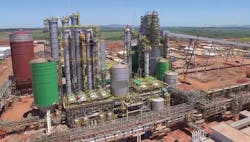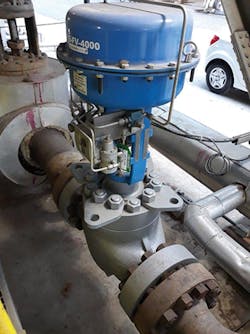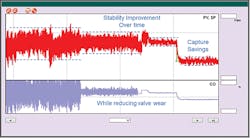Klabin's Puma wood pulp plant optimizes with valves, positioners and software
It's no surprise that efficiency hogs the stage in most sustainability discussions because it's already a familiar way to save resources, and easily tack on the popular motivation of reducing some environmental impacts. Most importantly, many end users are already doing it to some degree, so they can simply do more of what they're already doing, and get some added credit for going green.
However, efficiency must be continuous and consistent to maintain its initial gains, and that's where stability comes in. It may play second fiddle to efficiency, but stability is just as well-known to process operators and engineers, and may be even more important to gaining sustainability over the long term.
"The mainstream components of sustainability are people, planet and profit, including socially responsible investing that's also included in most environmental, social and governance (ESG) guidelines," says George Buckbee, who just retired from the Performance Solutions division at Neles Corp. "A higher-level, top-down view is taken by everyone from investors to young people. Sustainability is a huge consideration for them, and they're asking more questions, which are rolling down through organizations and becoming endemic concerns for them."
Cristian Moraes, head of Performance Solutions at Neles, reports that Expertune PlantTriage recently added new assessments and calculations for energy savings, which can provide its analysis and controls software and services to more types of equipment and processes. "These capabilities can decrease variability and save revenue, but they can also target each user's approach to sustainability. Some want to reduce energy consumption or carbon emissions, while others want to reduce chemical consumption. These days, you can't just save money—you have to also reduce waste and improve safety at the same time."
Moraes adds that Neles' clients always have specific goals based on the individual characteristics of their applications and facilities, but their sustainability tasks don't end there. "End users are also saddled with the fact that today's sustainability efforts are more visible," adds Moraes. "Many companies have publicly stated sustainability goals, so there's more awareness and they need to show greater transparency.
Pulp process performance
To better optimize wood pulp and power production, Klabin's five-year-old Puma pulp plant in Paraná, Ortigueira, Brazil, spent two years refining its application by expanding its partnership with Neles, adding more of its valves and other devices, and adopting its ExperTune PlantTriage software.
The facility makes short-fiber pulp from eucalyptus, long-fiber pulp from pine, and fluff pulp for diapers and other absorbent products. The plant simultaneously produces a total of 1.1 million tonnes per year of bleached hardwood pulp and 400,000 tonnes/year of bleached softwood and fluff pulp, but it's also designed to use renewable fuels such as wood, tree bark and lignin to generate 270 megawatts (MW) of electricity, consuming 120 MW internally and exporting up to 150 MW to Brazil's national grid. Klabin's 18 mills are reported to be similarly self-sufficient in power generation (Figure 1).
The Puma plant's pulp and power production is managed by 38 DCSs, 15,000 I/O and about 2,900 other devices networked via Profibus. Its present phase operates 2,000 automatic valves and 2,700 instruments for measuring temperature, pressure, flow and level. To coordinate these devices, manage all their data, and maintain stable pulp production, Puma automatically monitors 600 control loops online according to Klabin's established KPIs.
Moraes reports PlantTriage lets operators and managers analyze the plant's data, and use it s a predictive tools for making real-time adjustments, such as adjusting the weight of its standardized cellulose bales. "The lack of tuning between the moisture and the steam control loops was a challenge, and adjustments were being made manually," explains Moraes. "With PlantTriage, the plant solved the problem, and now every bale is consistently produced.”
Figure 2: Before adding a customized Neles globe valve and intelligent positioner to its boiler, Klabin previously installed ND9000 positioners from Neles on 20 valves at the Puma plant, and added 12-inch Neles ball valves at the outlets of its mass tanks. The company delivered a total of 1,800 valves, each equipped with ND9000 smart control valve positioners or on-off valve monitors. Source: Klabin and Neles
Value added by valves
On the hardware side, Klabin further enabled operations at the Puma plant by installing a customized Neles globe valve on its boiler. An earlier engineering study simulated that valve's operating conditions, and compared it to actual data that indicated how the device would need to be customized. This included incorporating particular alloys for the valve body, and selecting suitable internal materials. The new valve also has an intelligent positioner, which enables remote diagnostics and anticipates failures (Figure 2).
“The valve development wasn't limited to standard technical specifications. It considered the variations of pressure, flow and the high mechanical stress that the piece undergoes in the field,” says Pablo Cadaval Santos, Klabin's industrial manager at the Puma plant. "This equipment operates under severe conditions, and is subject to high pressure, in some cases up to 100 bar. The new valve gives stability to the operation and doesn't present premature degradation due to the correct application.”
During its initial Puma I construction phase, Klabin previously installed ND9000 positioners from Neles on 120 valves, and added 12-inch Neles ball valves at the outlets of its mass tanks . These valves replaced knife gate-type devices originally planned for the project. When the plant was expanded during its Puma II project, Neles became its leading valve and positioner supplier, and delivered 1,800 valves, each equipped with ND9000 smart control valve positioners or on-off valve monitors.
Less variability, more stability
To manage the 600 loops controlling its process devices, Klabin also installed PlantTriage during the Puma II phase.
Figure 3: Operators at Klabin's Puma plant tuned their 600 control loops, reduced variability and stabilized their fiber line and other pulp-related processes with help from ExperTune PlantTriage software. In less than a year, its staff reduced average absolute error from the variable average of 25-30% to a level of 15%, and two years after starting, it reached the current average of 1.5%. This stability lets operators maintain quality standards, produce better pulp products, and better control variable costs. Source: Klabin and Neles
“Tuning control loops is essential for stabilizing processes and reducing control errors. When the plant started up, we had room for adjustments, and we made them," says Santos. "In less than a year, we reduced average absolute error from the variable average of 25-30% to a level of 15%. Two years after starting, we reached the current average of 1.5%.”
For instance, Santos and his team dramatically reduced variability on the Puma plant's fiber line, so that it presently runs with only a minor error rate (Figure 3). Fewer errors and less variability stabilizes the fiber line and other processes at the plant, which enables them to maintain quality standards, produce better pulp products, and better control variable costs throughout the year. Likewise, if process parameters only vary within specified control error limits, then only a small amount of chemical additives need to be consumed. These fine-tuned control loops also make it easier to track who's operating and maintaining the plant. Finally, reduced variability and increased stability also reduced alarm rates, lightened workloads of Puma's operators, and let them focus more on value-added process optimization.
Savings and sustainability
Whatever combination of optimization and/or sustainability objectives users desire for their processes, they can likely be achieved by upgrading to modernized analytics software and support devices. However, Buckbee and Moraes add some common-sense preparations are also needed for these projects to succeed.
"Users need to be clear about what they want, so they need to survey their plant landscape and find opportunities to save and optimize. Unfortunately, if they haven't tracked performance over time, they often don't know where those opportunities are," explains Moraes. "If it's hard to figure out where to start, they can begin with the largest likely energy users such as distillation units or reactors. Other areas that are often overlooked are utilities. If users have been controlling these processes manually, they aren't getting the benefits they could be, but they won't know without the fundamental data showing it."
Similarly, Buckbee adds that one of the biggest potential contributors to sustainability is establishing daily and weekly data workflows, which support operations by allowing users to take more targeted action to improve daily performance. "One of our most important services is sitting down with the staff at a plant, going over existing workflows, and determining who is the right person to get certain information, and who is the right person to act on it," says Buckbee. "For example, if a boiler tripped last night, the questions are why, how was it set up, did instruments freeze, and how was the process upset? A lot of data usually floods in when an event like occurs, but much of it's often unused. I think Gartner reports that less than 0.5% of collected process data is ever used, even after it's been analyzed.
"However, achieving greater sustainability is going to require making better use of data in daily workflows, not just what's already on spreadsheets, and integrating sustainability back into those workflows. Operators and engineers must track sustainability efforts, show they have value, get their managers to buy in, and get their organization's whole food chain involved, as well as their suppliers and customers."
About the Author

Leaders relevant to this article:




